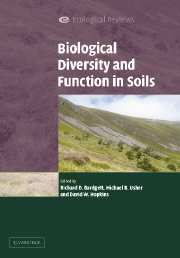Book contents
- Frontmatter
- Contents
- List of contributors
- Preface
- Acknowledgements
- PART I Introduction
- PART II The soil environment
- PART III Patterns and drivers of soil biodiversity
- PART IV Consequences of soil biodiversity
- 10 Microbial community composition and soil nitrogen cycling: is there really a connection?
- 11 Biodiversity of saprotrophic fungi in relation to their function: do fungi obey the rules?
- 12 Is diversity of mycorrhizal fungi important for ecosystem functioning?
- 13 Trophic structure and functional redundancy in soil communities
- 14 Plant–soil feedback and soil biodiversity affect the composition of plant communities
- 15 Response of the soil bacterial community to perturbation
- PART V Applications of soil biodiversity
- PART VI Conclusion
- Index
- References
15 - Response of the soil bacterial community to perturbation
Published online by Cambridge University Press: 17 September 2009
- Frontmatter
- Contents
- List of contributors
- Preface
- Acknowledgements
- PART I Introduction
- PART II The soil environment
- PART III Patterns and drivers of soil biodiversity
- PART IV Consequences of soil biodiversity
- 10 Microbial community composition and soil nitrogen cycling: is there really a connection?
- 11 Biodiversity of saprotrophic fungi in relation to their function: do fungi obey the rules?
- 12 Is diversity of mycorrhizal fungi important for ecosystem functioning?
- 13 Trophic structure and functional redundancy in soil communities
- 14 Plant–soil feedback and soil biodiversity affect the composition of plant communities
- 15 Response of the soil bacterial community to perturbation
- PART V Applications of soil biodiversity
- PART VI Conclusion
- Index
- References
Summary
SUMMARY
Molecular biological methods have provided new insights into the true extent of bacterial diversity in soil, and here we focus on their application in tandem with soil process measurements.
Data from a field experiment are used to illustrate the impact of perturbation on the total bacterial community as well as those functional groups responsible for nitrification, denitrification, methanogenesis and methane oxidation. Increasing the organic matter by about 20% by sewage sludge addition had no statistically significant effect on soil respiration rates, and although methanogenesis and methane oxidation were both stimulated, the effect was short lived and variable. We argue that the methane transformations are particularly dependent on unevenly distributed microsite activity, unlike nitrification/denitrification rates, which were stimulated by liming and organic matter addition in a manner that was both reproducible and persistent. The genetic diversity of the ammonia-oxidising bacteria concomitantly decreased, implying classical selection or enrichment of competitive species upon perturbation.
Effects on the diversity of the soil bacterial flora quickly disappeared with time, and we argue that seasonal variation, and particularly its effect on plant growth, has a greater impact on the dynamics of bacterial populations in soil than single time-point perturbations aimed at stimulating general biological activity. However, time course experiments revealed that the bacterial diversity in untreated soils was more stable, as the 16S rRNA gene profiles were more stable than those that developed in disturbed soils.
[…]
- Type
- Chapter
- Information
- Biological Diversity and Function in Soils , pp. 273 - 292Publisher: Cambridge University PressPrint publication year: 2005



